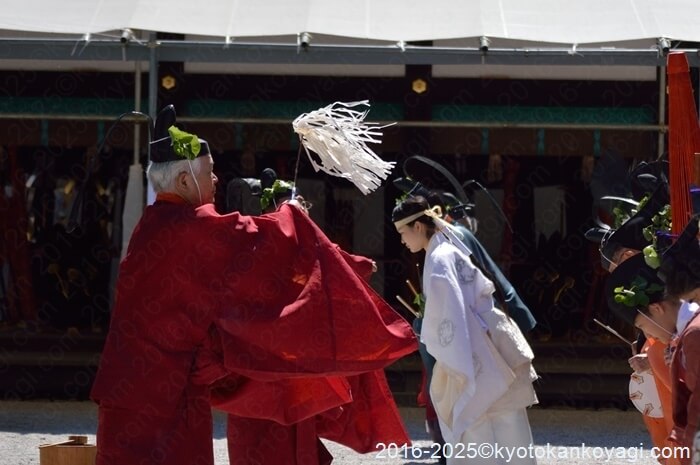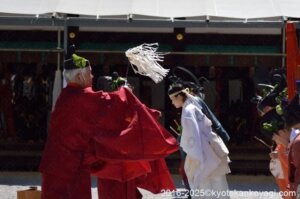Introduction
Matsuri is held in order to show gratitude, respect for Kami or to ask for something to them with offerings and artistic performances. This post will be revised. This is ver. 2.1
The aim of Matsuri and Kami 祭の本義と神
The aim 本義
Matsuris take place for many reasons and the most important ones are success in harvest and prevention of natural disasters and epidemics. In order to achieve these aim, we, in many cases priests, hold Matsuri for Kami (神).
In addition to it, we “revise” our lives taking advantage of Matsuri. Through our lives, we gain Kegare, the anemic state of mind. We get rid of it in Matsuri by means of the enormous power of Kami.
And Kami also revised before Matsuri. For example, in Mikage Matsuri, the Matsuri held prior to Aoi Matsuri, Kami of Shimogamo shrine is reborn.

Kami 神
Our ancestors found Kami in their deceased ones. It is easy to understand that they could be guardians of them.
In addition to it, they also find Kami in our ancestors and nature or natural phenomena.
They found personalities behind nature and natural phenomena. When we say “Kami,” it means this personification in many cases. Kami gives us prosperities of cultivation and they prevent us from natural disasters “if we treat them well.”
“If we treat them well” is important to understand Kami. It is a personalized nature or natural phenomena. Ancient people in Japan thought Kami behaves like them. They have desires and love arts and they applied the same kind of relationship found in their society: With good things, Kami does good for them, vice versa.
When we say “Kami,” the word includes at least these two meanings.
The faith of Goryo and Ekijin 御霊信仰と疫神
Furthermore, there are two important Kami: Goryo and Ekijin.
Around the 8th century, a centralized government was established and many political conflicts happened in the developing society. People started to think that natural disasters were caused by Goryo, the resented soul, of the victims of these conflicts.
To get rid of them, the cause of disasters, people tried to calm Goryo down half in fear, half in respect. This is the faith of Goryo. The most famous Goryo is Sugawareno Michizane enshrined in Kitano Tenmangu shrine.

Ekijin is Kami causes disease like epidemic. At first, when epidemic outbreaks, people thought Ekijin is a cause and held Matsuri to get rid of it. Later, they tried to ask him to save them from epidemic. The faith of Ekijin paved the way for the faith of (Gozu) Tenno. Gozu Tenno is the most famous Ekijin of Onmyodo (Not the Way of Yin and Yang in China but a religion invented in Japan). He is enshrined in Yasaka shrine. The aim of Gion Matsuri is to ask him to get rid of epidemic.

What is Matsuri? 祭の意義
Definition 意義
“祭 (Matsuri)” and was originated from many words. The most important ones are “Matsuru” and “Matsurou/Matsurau.”
Matsuru is a verb that means to do something for someone superior. Matsurou/ Matsurau also is a verb that means to serve for someone superior.
The meaning of the verb gave birth to Matsuri: To offer hospitality to Kamis to be near them in order to share their mysterious power.
There are many ways to be done and the most important ones are to serve meals and to play music and other performances. With these acts, people thought they could be close to them.
What does “祭” mean? 漢字の意味
Kanji is introduced in the 1st century from ancient China. Matsuri is written as “祭” and it is very reasonable why our ancestors adopted the Kanji to describe “Matsuri.”
祭
The Kanji is a hieroglyph and consists of three parts:
- The upper left means a peace of flesh as a sacrifice.
- The upper right means a hand.
- The center means a table with the peace of flesh on.
As indicated in the Kanji, the most important deed in Matsuri is to give offerings. The important things to be offered are Shinsen/ Mike (神饌) and Kabu (歌舞).
Matsuri of Shinto 神道祭祀
Two Matsuris 二つの祭
According to the definition, there are two kinds of Matsuri. Saishi is equivalent to Matsuri.
- 祖先祭祀 Sosen Saishi
- 磐座・聖水祭祀 Iwakura and Seisui Saishi
#1 is Matsuri for deceased ancestors and #2 is Saishi for nature.
Shinsen/ Mike and Kabu
Shinsen/ Mike
Shinsen/ Mike (神饌) means a meal for Kami. To serve Shinsen is called “献饌 (Kensen).”
Today, priests basically hold Matsuri in this way and they couldn’t be omitted.
- 修祓 (Syubatsu): To Harae preparing for a Matsuri.
- 神饌献撤 (Shinsen Kentetsu): To serve and put away Shinsen.
- 祝詞奏上 (Norito Sojo): To read out words for Kami.
- 礼拝 (Reihai/ Raihai): To give prayers to Kami.
Shinsen/ Mike consists of rice, Sake, rice cakes, grains, fishes, vegetables, seasonings, water, and so on.

In this video, a cook prepares Shinsen for Kami in Awata Matsuri. Shinsen is so sacred he never touches a fish with his hands. He cooks it only with long chopsticks and a knife.
Kabu Soujo
Kabu (歌舞) means music and dance performance.
In Mikage Matsuri, Kami heads for Shimogamo shrine by way of Kamohani shrine. This is a dance performance at Kamohani shrine.
In this video, around 11:22, a Mikoshi with Gozu Tenno on arrives at Otabisho and Gagaku music is performed. Later, he leaves the Mikoshi to enter Otabisho and music is performed. (Not in the video because I don’t want to shoot rituals)
Summery
Matsuri is an act of people for Kami. We can find Kami in deceased ancestors, nature, or natural phenomena. In Matsuri, we ask them to give us prosperity or to prevent us from natural disasters and diseases. This post will be revised. This is ver. 2.1. Thank you for reading. 合掌




